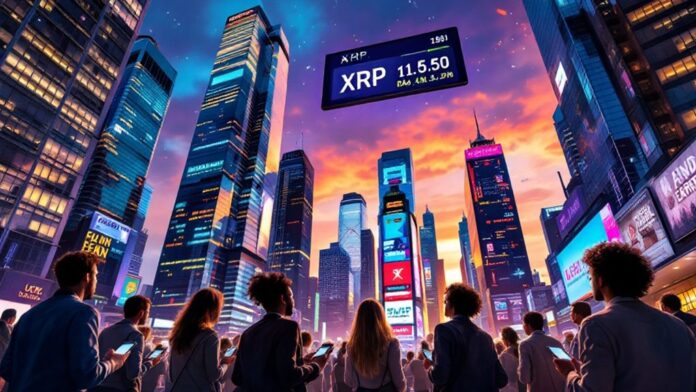XRP’s popularity stems from its lightning-fast transaction speeds, which handle over 1,500 transactions per second without traditional miningThe process of validating blockchain transactions by solving. With backing from Ripple and partnerships with major players like Santander and American Express, its credibility and usage soar. XRP bridges traditional finance with blockchainA decentralized ledger that records transactions across a ne, offering efficient cross-border solutions by cutting settlement times drastically. Its scalabilityThe capability of a blockchain network to handle increasing and decentralized nature eliminate intermediaries, enhancing security and efficiency. Discover how XRP’s innovative approach is shaping digital finance.
Lightning-Fast Transaction Speeds and Scalability
When you explore XRP’s capabilities, its lightning-fast transaction speeds and impressive scalability immediately stand out. XRP processes transactions in just seconds, a feat that stems from its consensus algorithm, which doesn’t rely on traditional mining. This efficiency not only minimizes transaction times but also markedly reduces costs, making XRP an attractive option for real-time cross-border payments.
As you investigate deeper, you’ll notice XRP’s ability to handle over 1,500 transactions per second. This scalability is essential in a digital age where speed and volumeThe total quantity of cryptocurrency traded within a specifi go hand in hand. XRP’s performance eclipses many of its cryptocurrencyA digital or virtual currency that uses cryptography for sec counterparts, positioning it as a leader in the race towards seamless global financial operations.
You’re witnessing the future of digital transactions unfold with XRP’s innovative technology.
Strong Backing and Strategic Partnerships
While exploring XRP’s ecosystem, you’ll find that its robust backing and strategic partnerships greatly bolster its market position.
Ripple, the company behind XRP, aligns itself with major financial institutions, providing a strong foundation for the cryptocurrency’s credibility. These collaborations enable you to see XRP’s potential impact on global financial systems.
Consider the following strategic partnerships that enhance XRP’s appeal:
- SBI Holdings: This Japanese financial giant’s backing amplifies XRP’s reach in Asian markets.
- Santander: By integrating XRP into its payment app, Santander showcases XRP’s utility in real-world banking.
- American Express: Their partnership with Ripple highlights the potential for seamless cross-border transactions.
- MoneyGram: XRP’s use in remittance services demonstrates its effectiveness in reducing transfer costs.
These alliances position XRP as a transformative force in digital finance.
Bridging Traditional Finance and Blockchain Technology
As XRP continues to gain traction, it’s crucial to recognize how it effectively bridges the gap between traditional finance and blockchain technology.
You see, XRP’s unique consensus protocol enables lightning-fast transactions, reducing settlement times from days to mere seconds. This efficiency appeals to financial institutions seeking to streamline cross-border payments.
Additionally, XRP’s interoperabilityThe ability of different blockchain systems to exchange and allows seamless integration with existing banking systems without overhauling infrastructure. By reducing costs and enhancing transparency, XRP attracts banks and payment providers looking for innovative solutions.
Moreover, its decentralized nature eliminates reliance on centralized intermediaries, bolstering security and trust.
As you explore XRP’s potential, consider how its ability to merge traditional finance with cutting-edge blockchain technology can revolutionize the financial landscape, providing a robust foundation for future developments.
Frequently Asked Questions
How Does Xrp’s Environmental Impact Compare to Other Cryptocurrencies?
You’ll find XRP’s environmental impact is lower than many cryptocurrencies. Its consensus algorithm, unlike Bitcoin’s proof-of-work, requires minimal energy. This efficiency aligns with innovation-driven goals, appealing to those prioritizing sustainability in blockchain technology.
What Makes XRP Different From Bitcoin and Ethereum?
You’ll find XRP stands out due to its consensus protocol, offering faster transactions and lower fees than Bitcoin and Ethereum. It’s designed for financial institutions, enhancing cross-border payments and providing a scalable, energy-efficient solution.
Is Xrp’s Price Volatility a Concern for Investors?
You’re right to contemplate XRP’s price volatility as a concern. However, this volatility can also present opportunities for innovative investors who thrive on market fluctuations and leverage advanced trading strategies to maximize potential returns amidst uncertainty.
How Does Xrp’s Use Case Affect Its Adoption Rate?
You see XRP’s adoption rate surge due to its efficient cross-border transaction capabilities. By lowering costs and speeding up transfers, it’s tailored for financial institutions embracing innovation, making it an attractive choice in the evolving digital currency landscape.
What Regulatory Challenges Does XRP Face Globally?
You face evolving regulatory challenges with XRP, including differing global legal interpretations and compliance requirements. Stay informed on international regulations, as these affect XRP’s integration into financial systems and your potential to innovate in decentralized finance solutions.



